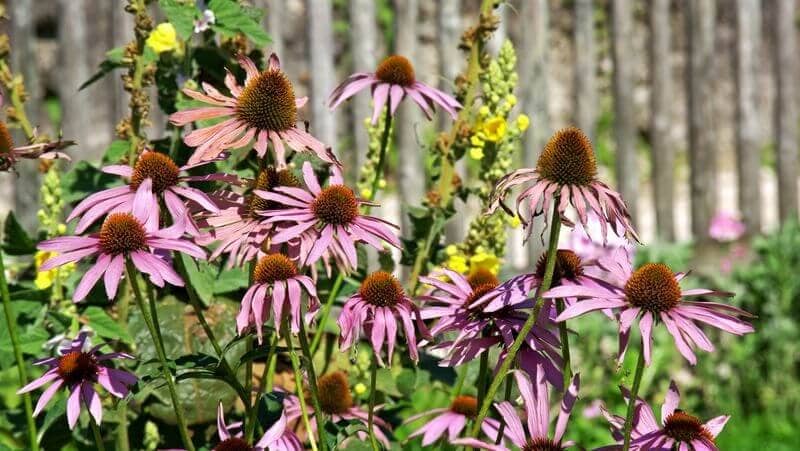Echinacea: Common Name Purple Cone Flowers
One of the best perennial flowers for late summer and early autumn is Echinacea Purpurea, a plant often referred to as the purple coneflower. There are several varieties of Echinacea now that are not purple. This plant is a native of N. America growing from Virginia to Ohio, Michigan, south to Georgia and Louisiana. It is found growing in open fields, dry open woods and prairies. A member of the compositae or daisy family, it is well known to gardeners and wildflower enthusiasts around the world.
Cultivation
Cultivation is easy Echinacea prefers light, loamy, well-drained soil and a sunny position, but it will tolerate dappled shade. This is a very ornamental plant; it attracts butterflies and useful insects into the garden such as bees and hover flies. The long lasting flowers with their slightly backward pointing flower petals when fully open, bloom from July through to end of September are good subjects for the flower border. The daisy-like flowers with large, rich purple or pink rays surround a high brownish-orange cone; bring a touch of summer to the borders.
The flower heads can reach 4 to 5 in. (10cn-13cm) in diameter. Stems are long 2 to 3 ft. (60cm-90cm) high, slender but stout, rough and bristly; the leaves are also bristly, and dark green. The roots are tapering, cylindrical, slightly spiral, and fibrous with as aromatic smell. Echinacea Purpurea is the most common species found in garden centres and nurseries but there are also some delightful cultivators available.
Medical Uses
Some months ago there was an epidemic amongst the members of my keep fit class, someone had discovered Echinacea for treating colds and the word quickly spread resulting in everyone rushing off to the health shop to get this fix remedy for their winter ails. Now I have been growing this plant and some of the varieties in my garden for several years and though I am well aware of its usefulness as an herbal treatment, I was not aware of just how popular an herbal treatment it is.
For centuries it has been used to treat various ailments such as poisonous insect and snake bites, toothaches, mumps, small pox, blood purifier, measles and as a general immune system enhancer. Apparently Echinacea is one of the top selling herbs in the US for its immune enhancing properties. Research has shown that taking Echinacea at the first sign of a cold or flu can decrease the duration and intensity of the symptoms.
Many people are familiar with its use in alternative medicine to support the immune system, and to purify the blood, especially during season changes and during the cold and flu season. Scientific studies have confirmed the presence of natural chemicals, which increase white blood cell activity.
The root now confirmed by modern science as an alterative, anti-inflammatory, antibiotic, antiseptic, aphrodisiac, depurative, diaphoretic, digestive, treatment. The roots and the whole plant are considered particularly beneficial in the external treatment of psoriasis, eczema and inflammatory skin conditions, sores, wounds, burns, and sore throat, possessing cortisone-like and antibacterial activity as well as showing skin regenerating properties.
It also contains chemicals that are highly repellent particularly to mosquitoes and houseflies. Of the several varieties of Echinacea the three most popular are Purpurea, Angustifolia and Pallida. They are harvested for their roots, flower heads, seeds, or juice of the whole plant and can then be made into capsules, extracts, tinctures and tea. Other species are probably just as effective medicinally but little research has been done on them.
Cultivation
Echinacea Purpurea is easy to grow. It is best suited for a poor to moderately rich, free draining soil so if yours is in any way heavy, mix in plenty of sharp sand and compost to help drainage and to lighten it up. You can sow them directly or start them indoors in pots with a little warmth to get them started. Sow on the surface of the soil and after the seeds begin to germinate lightly cover the seeds with about 1/8 in. (3mm) of soil.
Germination should occur within 10-20 days. After germination the plants will grow very quickly. Thin the plants out so that they are 18 to 24 in. (45cm-60cm) apart. All they require is a rich moist but well drained soil in full sun. Be sure to control weeds, as Echinacea will perform much better without competition.
Every four or five years your plant will probably have to be divided. The best time to split a large plant into two is after it has flowered. You can dig up the whole plant, cut the root ball in half, add new soil to the hole and replant half and relocate the other. Leave enough time at the end of the season for the plant to re-establish itself before winter.
Varieties:
Echinacea Pallida: An elegant sweet-scented coneflower with spidery petals. Fine border and cut flower.
Echinacea Paradoxa White Swan: Strong honey fragranced flowers in 16 weeks, often with 14+ 4-4.5in blooms out at once. Long lived for border, bedding or cutting.
Echinacea Paradoxa var. paradoxa: A real paradox! This is the rare and most unusual 'purple cone flower' with yellow flowers. Back in 1902 it was first named Brauneria paradoxa and after further changes to its taxonomy is now a member of the Echinaceas. A prized and seldom offered border plant.
Echinacea Purpurea Magnus: An outstanding selection of the 'Cone Flower', distinguished by the warm bright colour of its exceptionally large flowers. The slender elegance and formality of its petals give it a style that will add class to larger flower arrangements. In the border it is no less valuable on account of its robust strong stems and general vigour which give 'Magnus' good wind and weather resistance.
Echinacea Purpurea: Their brilliant carmine colour, huge flowers and 'cut and come again' capabilities achieve a stunning effect in the garden and for house decoration. Strong stemmed, very weather resistant and much longer lived than their close relation the Rudbeckia. Easy perennials for beds and borders, tolerating dry soil and wind. Flower in their first season from an early sowing. Flowers mid summer to winter. Height 1m (36in).
Pests and Disease
There have been no significant diseases found which affect the roots of Echinacea plants, but cucumber mosaic virus has been noted to cause yellow mottling on the leaves. This appears to be a direct reaction to aphid leaf infestation. Therefore, aphid control on young plants is recommended.
Harvesting
Autumn is the best time to harvest Echinacea roots, - harvest after the first frost. Expect roots to range from 8 in. (20cm) to a possible 24 in. (30cm). The moisture content is normally lower than it is in spring. Plants are required to grow for three to four years before they are ready to be harvested. Once roots have been harvested they should be cleaned and dried. Two possible methods for drying the roots are, under low forced heat, or dried in open air in the sun.When harvesting seed heads for seed, it is best to harvest at the end of summer close to the first frost when the stalks are brown and brittle. Harvesting the flowers is done in mid July when they are in full bloom.
Pick flowers first thing in the morning for optimum medicinal quality. Process the same day preferably within four hours (for fresh tincture): Dry the plant material fast and cool (artificially). Harvesting for the whole plant - cut in full bloom just after dew has dried, but not in the heat of the day for optimum medicinal quality. Process the same day preferably within four hours (for fresh tincture).
Processing and Drying: Drying of the herb is easily accomplished, however, it should be noted that drying at a moderate temperature of 20 - 25 degrees Celsius works best. The different parts of the plant will require various amounts of time to dry effectively, with the herbage and seed heads taking the longest.


